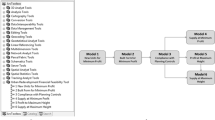Abstract
The monitoring of town centers has become very important to Her Majesty’s Government (HMG) over the past 15 years. This paper describes how a GIS-based tool has been devised for the defining and monitoring of English town centers and its role in the English planning system. Ultimately, the objective and empirical measurement of something as conceptual as a “town center” is not an easy task, and some of the difficulties of carrying this out are discussed.
A further proposal is put forward to adapt the town centers methodology to produce a new tool for modeling housing capacity.
Similar content being viewed by others
Notes
- 1.
See www.statistics.gov.uk/abi/ for more detail
- 2.
See www.statistics.gov.uk/abi/sic92_desc.asp for more detail
- 3.
See www.voa.gov.uk/business_rates/index.htm for more detail.
- 4.
See The Town and Country Planning (Use Classes) Order 1987(www.opsi.gov.uk/si/si1987/Uksi_19870764_en_1.htm) for more details on the use classes.
- 5.
- 6.
Data published by Communities and Local Government as part of their housing statistics Live Tables-http://www.communities.gov.uk/housing/housingresearch/housingstatistics/housingstatisticsby/
- 7.
Data published by Communities and Local Government as part of their monthly House Price Index Statistical Release - http://www.communities.gov.uk/housing/housingresearch/housingstatistics/housingstatisticsby/housingmarket/publications/house-price-index/
- 8.
References
Bach M and Thurstain-Goodwin M (2006) Future of retail property: in town or out of town? Geofutures Ltd and British Council of Shopping Centres
Barker K (2003) Review of housing supply: interim report - analysis. HMSO, Norwich
Barker K (2004) Review of housing supply: final report - recommendations. HMSO, Norwich
Bramley G (2007) The sudden rediscovery of housing supply as a key policy challenge. Housing Studies 22: 221–241
Department of the Environment Transport and the Regions (1998) Town centres: defining boundaries for statistical monitoring feasibility study. The Stationery Office, London
Gardner C and Sheppard J (1989) Consuming passion: the rise of retail culture. Unwin Hyman, London
Garreau J (1991) Edge city: life on the new frontier. Doubleday, New York
Guy CM (1982) ‘Push-button shopping’ and retail development. Department of Town Planning, UWIST, Cardiff
Guy CM (1994) The retail development process: location, property, and planning. Routledge, London
Guy CM (1995) Retail store development at the margin. J. of Retailing and Customer Services 2: 25–32
Guy CM (1998) Off-centre retailing in the UK: prospects for the future and the implications for town centres. Built Environment 24: 16–30
Lloyd DA (2005) Uncertainty in town centre definition. PhD thesis, UCL, London
Lloyd DA, Haklay M, Thurstain-Goodwin M and Tobón C (2003) Visualising spatial data structure in urban data. In: Longley PA and Batty M (eds) Advanced spatial analysis: the CASA book of GIS. ESRI Press, Redlands, CA, pp 267–288
Lowe MS (1998) The Merry Hill regional shopping centre controversy: PPG6 and new urban geographies. Built Environment 24: 57–69
Lowe MS (2000) Britain’s regional shopping centres: New urban forms? Urban Studies 37: 261–274
Meen G (2005) On the economics of the barker review of housing supply. Housing Studies 20: 949–971
Murphy A (2002) The emergence of online food retailing: a stakeholder perspective. Tijdschrift voor economische en sociale geografie 93: 47–61
Office of the Deputy Prime Minister (2002a) Producing boundaries and statistics for town centres: London pilot study summary report. The Stationery Office, London
Office of the Deputy Prime Minister (2002b) Producing boundaries and statistics for town centres: London pilot study technical report. The Stationery Office, London
Office of the Deputy Prime Minister (2005) Government response to Kate Barker’s review of housing supply. HMSO, London
Ravenscroft N (2000) The vitality and viability of town centres. Urban Studies 37: 2533–2549
Ravenscroft N, Reeves J and Rowley M (2000) Leisure, property, and the viability of town centres. Environment and Planning A 32: 1359–1374
Schiller R (1986) The coming of the third wave. Estates Gazette 279: 648–651
Schiller R (2001) The dynamics of property location. Spon, London
Schuurman N (2000) Trouble in the heartland: GIS and its critics in the 1990s. Progress in Human Geography 24: 569–590
Sparks L (1996) The Census of Distribution: 25 years in the dark. Area 28: 89–95
Taylor PJ (1995) Geographic information systems and geography. In: Pickles J (ed) Ground truth: the social implications of geographic information systems. Guilford Press, London, pp 51–67
Taylor PJ and Overton M (1991) Further thoughts on geography and GIS – a preemptive strike. Environment and Planning A 23: 1087–1090
Thomas CJ (1989) Retail change in Greater Swansea: evolution or revolution. Geography 74: 201–213
Thomas CJ and Bromley RDF (2002) The changing competitive relationship between small town centres and out-of-town retailing: town revival in South Wales. Urban Studies 39: 791–817
Thurstain-Goodwin M and Unwin DJ (2000) Defining and delineating the central areas of towns for statistical monitoring using continuous surface representations. Transactions in GIS 4: 305–317
Thurstain-Goodwin M and Batty M (2001) The sustainable town centre. In: Layard A, Davoudi S and Batty S (eds) Planning for a sustainable future. Spon, London, pp 253–268
Author information
Authors and Affiliations
Corresponding author
Editor information
Editors and Affiliations
Rights and permissions
Copyright information
© 2009 Springer-Verlag Berlin Heidelberg
About this chapter
Cite this chapter
Lloyd, D.A. (2009). GIS-based Applications and the English Planning System: Modeling Town Centers and Housing Potential. In: Hagen, H., Guhathakurta, S., Steinebach, G. (eds) Visualizing Sustainable Planning. X.media.publishing. Springer, Berlin, Heidelberg. https://doi.org/10.1007/978-3-540-88203-9_3
Download citation
DOI: https://doi.org/10.1007/978-3-540-88203-9_3
Published:
Publisher Name: Springer, Berlin, Heidelberg
Print ISBN: 978-3-540-88202-2
Online ISBN: 978-3-540-88203-9
eBook Packages: Computer ScienceComputer Science (R0)




